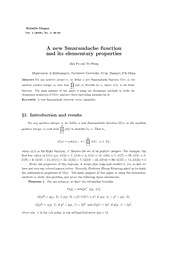Table Of ContentScientia Magna
Vol. 4 (2008), No. 3, 26-28
A new Smarandache function
and its elementary properties
Jing Fu and Yu Wang
Department of Mathematics, Northwest University, Xi’an, Shaanxi, P.R.China
Abstract For any positive integer n, we define a new Smarandache function G(n) as the
(cid:89)m
smallest positive integer m such that φ(k) is divisible by n, where φ(n) is the Euler
k=1
function. The main purpose of this paper is using the elementary methods to study the
elementary properties of G(n), and give three interesting formulas for it.
Keywords A new Smarandache function, series, inequality.
§1. Introduction and results
For any positive integer n, we define a new Smarandache function G(n) as the smallest
(cid:89)m
positive integer m such that φ(k) is divisible by n. That is,
k=1
(cid:89)m
G(n)=min{m: n | φ(k), m∈N},
k=1
where φ(n) is the Euler function, N denotes the set of all positive integers. For example, the
first few values of G(n) are: G(3) = 7, G(4) = 4, G(5) = 11, G(6) = 7, G(7) = 29, G(8) = 5,
G(9)=9, G(10)=11, G(11)=23, G(12)=7, G(13)=43, G(14)=29, G(15)=11, G(16)=5
···. About the properties of this function, it seems that none had studied it yet, at last we
havenotseenanyrelatedpapersbefore. Recently,ProfessorZhangWenpengaskedustostudy
the arithmetical properties of G(n). The main purpose of this paper is using the elementary
methods to study this problem, and prove the following three conclusions:
Theorem 1. For any prime p, we have the calculating formulae
G(p)=min{p2, q(p, 1)};
G(p2)=q(p, 2), if q(p, 2)<p2; G(p2)=p2, if q(p, 1)<p2 <q(p, 2);
G(p2)=q(p, 1), if p2 <q(p, 1)<2p2; and G(p2)=2p2, if q(p, 1)>2p2,
where q(p, i) is the i-th prime in the arithmetical series {np+1}.
Vol. 4 AnewSmarandachefunctionanditselementaryproperties 27
Theorem 2. G(n) is a Smarandache multiplicative function, and moreover, the Dirichlet
(cid:88)∞ G(n)
series is divergent.
n2
n=1
Theorem 3. Let k ≥ 2 be a fixed positive integer, then for any positive integer group
(m , m , ··· , m ), we have the inequality
1 2 k
G(m m ···m )≤G(m )G(m )···G(m ).
1 2 k 1 2 k
Note. For any positive integer n, we found that n = 1, 4, 9 are three positive integer
solutions of the equation G(n) = n. Whether there exist infinite positive integers n such that
the equation G(n) = n is an interesting problem. We conjecture that the equation G(n) = n
has only three positive integer solutions n=1, 4, 9. This is an unsolved problem.
§2. Proof of the theorem
Inthissection,weshallcompletetheproofofourtheoremsdirectely. FirstweproveTheo-
(cid:89)m (cid:89)s
rem1. LetG(p)=m,namelyp| φ(k),p (cid:45) φ(k),0<s<m. Ifm=qα1qα2···qαr bethe
1 2 r
k=1 k=1
factorization ofm intoprime powers, thenφ(m)=q1α1−1(q1−1)q2α2−1(q2−1)···qrαr−1(qr−1),
from the definition of G(n) we can deduce that p divides one of φ(qαi), 1≤i≤r. So p divides
i
qαi−1 or q −1. We discuss it in the following two cases:
i i
(i). Ifp|q −1,thenwemusthavem=q =lp+1bethesmallestprimeinthearithmetical
i i
series {kp+1}.
(ii). If p | qαi−1, then we have have α =2, m=q2 =p2.
i i i
Combining (i) and (ii) we may immediately deduce that G(p) = min{p2, lp+1}, where
lp+1 be the smallest prime in the arithmetical series {kp+1}. Similarly, we can also deduce
the calculating formulae for G(p2). This proves Theorem 1.
Now we prove Theorem 2. For any positive integer n > 1, let n = pα1pα2···pαr be the
1 2 r
factorization of n into prime powers, G(pαi) = m , 1 ≤ i ≤ r, m = max{m , m , ··· , m },
i i 1 2 r
thenfromthedefinitionofG(n)wehavepαi dividesφ(1)φ(2)···φ(m )forall1≤i≤r. Sopαi
i i i
divides φ(1)φ(2)···φ(m). Since (pi, pj)=1, i(cid:54)=j, so we must have n=pα11pα22···pαrr divides
φ(1)φ(2)···φ(m). Therefore, G(n) = m = max{G(pα1), G(pα2), ··· , G(pαr)}. So G(n) is a
1 2 r
Smarandache multiplicative function. From Theorem 1 we may immediately get
(cid:88)∞ G(n) (cid:88)G(p) (cid:88)1
> > =∞.
n2 p2 p
n=1 p p
(cid:88)∞ G(n)
So the Dirichlet series is divergent.
n2
n=1
Finally,weproveTheorem3. FirstweprovethattheinequalityG(m m )≤G(m )G(m )
1 2 1 2
holds for any positive integer m and m .
1 2
Let G(m )=u, G(m )=v, from the definition of G(n) we can easily get
1 2
(cid:89)u (cid:89)v
m | φ(i) , m | φ(i).
1 2
i=1 i=1
28 JingFuandYuWang No. 3
Without loss of generality we can assume u≤v, then
(cid:89)uv (cid:89)u (cid:89)uv (cid:89)u
φ(k)= φ(k)· φ(k)= φ(k)·φ(u+1)···φ(v)···φ(2v)···φ(uv)
k=1 k=1 k=u+1 k=1
Notice that
φ(2) | φ(2v), φ(3) | φ(3v), ··· , φ(u) | φ(uv), φ(u+1) | φ(u+1), ··· , φ(v) | φ(v),
this means that
(cid:89)v (cid:89)uv
φ(i) | φ(k),
i=1 k=u+1
or
(cid:89)u (cid:89)v (cid:89)uv
φ(i) φ(i) | φ(k).
i=1 i=1 k=1
Hence
(cid:89)uv
m m | φ(k).
1 2
k=1
From the definition of G(n) we know that G(m m )≤uv, or
1 2
G(m m )≤G(m )G(m ).
1 2 1 2
If k ≥3, then applying the above conclusion we can deduce that
G(m m ···m )=G(m (m ···m ))≤G(m )G(m ···m )
1 2 k 1 2 k 1 2 k
≤G(m )G(m )G(m ···m )
1 2 3 k
·········
≤G(m )G(m )···G(m ).
1 2 k
This completes the proof of Theorem 3.
References
[1] F. Smarandache, Only Problems, Not Solutions, Chicago, Xiquan Publishing House,
1993.
[2]TomM.Apostol,IntroductiontoAnalyticNumberTheory,NewYork,Springer-Verlag,
1976.
[3]PanChengdongandPanChengbiao,Theelementarynumbertheory,BeijingUniversity
Press, Beijing, 1988.
[4] Zhang Wenpeng, The elementary number theory, Shaanxi Normal University Press,
Xi’an, 2007.
[5] Kenichiro Kashihara, Comments and topics on Smarandache notions and problems,
Erhus University Press, 1996.

